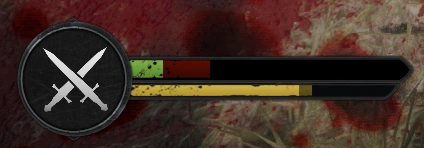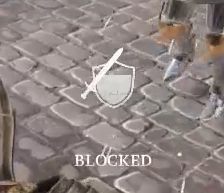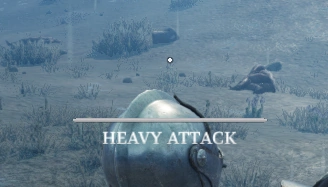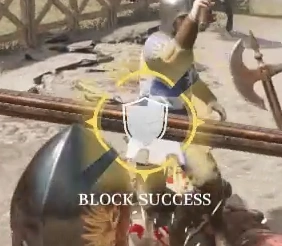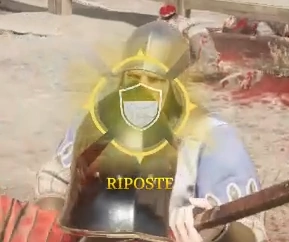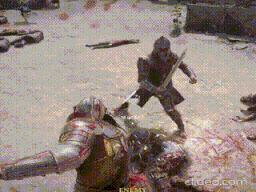Combat (Chivalry II)
Combat is at the heart of Chivalry II's gameplay. This article explains the mechanics of combat in the game.
Initiative
The combat system in Chivalry 2 is designed such that, after a player makes an initial attack, they will be unable to perform a second attack before their opponent can make an attack of their own. This system is known as initiative. The combatants will trade initiative back and forth until one prevails over the other. Awareness of which player currently holds initiative is crucial to succeeding in combat.
At the beginning of a fight, or whenever a player choose not to attack on their turn, initiative resets. In these situations, the player who attacks first will take the initiative.
Stealing Initiative
As there is nothing preventing a player from acting outside of the initiative turn order, a player may attempt to steal initiative (also know as gambling) by attacking instead of blocking while their opponent has the initiative, This is risky as an opponent’s attack will generally hit first and interrupt the player. However, stealing initiative can be effective where an opponent is feinting or making a heavy attack, as the extra time needed for those actions can leave an opening for the player’s hit to land first.
Health and Stamina
Each Class has its own pool of health and stamina.
Health
Health (or hit points) represents a player’s armour and ability to withstand damage. It is tracked by a green bar at the bottom right corner of the screen. When a player takes damage, part of the bar will briefly turn dark red to indicate the amount of damage taken, before turning black. When a player receives Healing, part of the bar will turn grey to indicate the amount of healing to be received, which will gradually turn green unless interrupted by damage.
Certain items, such as the Officer's and Raider's horn can provide overheal, up to 20 additional hit points represented by a green shield beside the health bar.
A player with low health who does not engage in combat for at least six seconds will begin to slowly recover health, up to 40% of their total. This recovery will be interrupted if the player takes any damage, attacks, or blocks.
A player whose health reaches zero will be knocked down or killed.
Stamina
Stamina is a resource that players spend to perform actions, such as feinting, comboing, blocking, and dodging. It is represented by a yellow bar directly below the health bar. Whenever a player performs an action which costs stamina, a portion of the bar will turn dark yellow to represent the cost of the action just performed. As well, when holding block, the shield icon will display the player's current stamina.
Stamina will gradually regenerate unless a player is crouching.
A player's first attack does not cost any stamina, but subsequent feints or combos will cost stamina. Ripostes do not cost stamina (beyond the cost of blocking the attack), but a counter attack will cost stamina.
If a player is low on stamina, their model will appear hunched over and can be heard panting. A player who is hit while out of stamina will drop their weapon and take some half damage. They will also stagger, resulting in a loss of initiative. After dropping their weapon their stamina will partially restore.
Attacking
Types of Attacks
All melee weapons in Chivalry 2 have three types of standard attacks. For most Weapons, these consist of slashes or swings (which arc horizontally), overheads (which arc vertically), and stabs (which extend forward). Three weapons, the Spear (1-Handed). Spear (2-Handed), and the Lance do not have slash attacks, and instead have a low stab (bound to slash) and an high stab (bound to stab). Any held object may also be thrown at an opponent to cause damage. Ranged weapons, such as the Bow and Crossbow, do not have slash attacks as that input is used to fire the weapon.
If an attack succeeds, one or more small numbers will appear to indicate the damage done to the opponent(s). If an opponent blocks the player's attack, the word "Blocked" will appear as will a shield icon with a small sword. The white fill level of the shield indicates the player’s remaining stamina. If an opponent counters the player's attack, the word "Countered" will appear, without a shield icon. In both cases, the player will have lost initiative.
Special Attack
Most weapons also have at least one special attack. Special attacks have unique animations and slow wind-ups. Special attacks typically do more damage than even heavy standard attacks and also have a brief staggering effect on the opponent, permitting the player who landed the special attack to retain initiative. Some weapons have multiple special attacks, which are tied to specific classes and are context dependent (for example, the Vanguard's leap attack).
Special attacks cost stamina.
Heavy Attacks
Each standard attack also has a heavy variant that deals additional damage. A heavy attack is performed by holding the attack input. A thin bar will begin to fill on the screen and, if filled, the words "Heavy Attack" will appear.
Heavy attacks cost stamina.
The animation for a heavy attack is the same as for a standard attack, however the heavy attack will spend additional time in its windup phase. A player performing a heavy attack will also have an extended grunt, which serves as an audio cue.
Because of the additional release time, a player intending to counter an opponent's heavy attack must wait correspondingly longer before beginning their attack from block. If they fail to do so, the heavy attack will land before their failed counter hits their opponent. Alternatively, a player who anticipates their opponent is going to make a heavy attack may perform an initiative-breaking standard attack in order to interrupt their opponent's heavy attack and deal damage.
Windup and Release
Each weapon has two phases in its attack: the windup and the release. The length of the windup and release varies from weapon to weapon. During the windup, the player will make a unique motion to signal they are beginning their attack. A weapon in windup cannot deal damage. After the windup completes, the weapon will release and any non-blocking player within the attack's arc will take damage. After the release there is a brief cooldown during which a player will not be able to block, dodge, or attack.
Feinting or cancelling an attack can only be done in the windup phase. This is important because if the player's attack does not make contact they will be locked into the release phase for its duration and may be vulnerable to an attack. To prevent this, a player may attempt to maneuver their attack into the ground or environment, which will immediately end the release phase.
Alternate Attacks
Each attack has two "directions" in which it may be made. The normal direction and the alternate or alt direction. A player's slash will always begin moving from right to left and then, if a combo is made, from left to right. Holding alt will cause the slash to begin from left to right. The same is true for overheads and stabs. Alternate slashes can be particularly effective in getting around an opponent's block.
Enabling "Attack Direction from Movement Input" will make attacks be normal or alternate based on the player's movement direction.
Combos
Inputting an attack immediately after a first, unblocked attack, ends will result in a combo, with the second attack skipping the windup phase. This means that a player who lands a successful hit on an opponent will retain initiative if they combo.
Comboing costs stamina. Blocked attacks cannot be comboed.
Interruption
A player is vulnerable during both the windup and release phase of the attack. If hit by an opponent's attack during this time, the player's attack will immediately be interrupted and will not deal further damage. The word "Interrupted" will appear in the centre of the screen.
Cancelling
A player may cancel an attack while it is still in the windup phase by hitting the cancel input. This returns the player to the neutral position and allow them to make another attack. Cancelling an attack costs a small amount of stamina. Jabs and kicks cannot be cancelled.
An attack can also be cancelled by blocking, at additional stamina cost.
Feints
A feint or morph is performed when a player inputs a different attack (including an alt attack) during the windup phase of their first attack. The feinted attack will release faster.
It is not possible to cancel or feint again from a feinted attack.
Feints are extremely important in high level play as a way to disrupt opponents' timing. An opponent attempting to counter a player's attack will fail and take damage unless they also feint to again match the player's attack.
Swing Manipulation
Since players can continue to move and look around during the windup and a release, it is possible to modify the arc the player's weapon travels. Common Techniques include accelerations (turning into the arc of a slash to make it move toward the opponent faster and drags (turning away from the arc of the slash to slow the weapon and cause an opponent to release block too early or expend additional stamina holding block).
Damage
Types of Damage
Weapons in Chivalry 2 deal one of three different types of damage. These are cut, chop, and blunt.
Cut Weapons, such as the Longsword and Bow deal the same damage to all weapons. Most cut weapons will also cleave, meaning they can hit multiple opponents in a single attack.
Chop Weapons, such as the War Axe and Dane Axe deal additional damage to the Footman (+17.5%) and Knight (+25%) classes. Chop weapons can also cleave.
Blunt Weapons, such as the Maul and Crossbow also deal additional damage to the footman (+35%) and Knight (+50%). However, melee blunt weapons will hitstop (that is, stop moving) upon contact with the first enemy. This puts them at a disadvantage in a 1vX situation.
When blocked, all weapons deal stamina damage equivalent to 1/3rd of their base damage.
Dismemberment
There is a random chance of dismembering an opponent with an attack. The chance of this happening appears to be increased with heavy attacks when the enemy is low on health. Both arms and legs can be dismembered in this manner. A player who has a limb dismembered will slowly bleed out. The bleed out can be stopped by doing enough
As all characters are right-handed, dismembering an opponent's right hand will leave them only able to punch, whereas dismembering their left hand will allow the player to continue to attack using a 1-handed weapon. A player who loses both arms can attack with a headbutt.
Blocking, Counters and Ripostes
Blocking
Blocking or parrying prevents incoming damage to the player at the cost of stamina. Certain damage, such as that from bows, crossbows, catapults, fire, and kicks are unblockable (though arrows and bolts can be countered). Damage from a ballista bolt can be blocked, but only if the player is carrying a shield.
To block, a player should aim at the tip of the opponent's weapon, not the opponent's character model. A shield icon will appear that displays the player's current stamina. On a successful block, the reticle around the block shield will turn yellow and the words "Block Success" will appear. A successful block will knock back the player slightly but also prevent the opponent from comboing, thus transferring initiative to the player.
Unlike in other games in the genre, Chivalry 2 allows the player to hold block. However, both raising block and holding block cost stamina. A kick will interrupt held block, staggering the opponent.
Ripostes
Riposte attacks are faster, and actively block incoming strikes for a time. - Chivalry 2 Tutorial
A riposte is performed by quickly starting an attack after successfully blocking an opponent's attack. There is a half-second window in which to perform the riposte. If performed properly, the reticle will turn yellow and the words "Riposte Success" will appear for the duration of the autoparry window.
Riposte attacks will provide the player with approximately half a second of autoparry, from the start of the swing. Any incoming attacks to the front of the player will be automatically blocked and thus the player's attack cannot be interrupted (though still can be blocked). Riposte attacks come out accelerated, such that even slow weapons like the maul can beat fast weapons like the Sword (1-handed) to a hit.
It is possible to feint into a different attack or from a successful riposte.
Because of its staggering effect, it is not possible to riposte after blocking a special attack. However, a special that lands within the autoparry window will be blocked without the staggering effect or stamina cost.
Counters
Attacking from block enables a short counter window that will deflect incoming strikes of the same type. Counters act as a “perfect parry” and avoid the stamina loss and knockback effects of normal blocks. - Chivalry 2 Tutorial
A counter is performed by matching an opponent's attack from block and releasing it before the opponent's hit lands. For example, if an opponent is using an overhead attack against the player, the player can counter by making an overhead from block. The player's attack must begin after the opponent's attack is released but before it lands. If performed properly, the reticle will turn blue and the words "Counter Success" will appear for the duration of the autoparry window. It is not necessary to match an opponent's use of alt or heavy attack, only the base attack (slash, overhead, or stab).
Counters are riskier than ripostes because if the player fails to match their opponent's attack, they will take damage. Successful counters negate the stamina and knockback effects of blocking. Thus, in a fight where one player is countering every attack and the other is riposting, the latter player will eventually run out of stamina and drop their weapon. Counter attacks will also provide approximately half a second of autoparry, from the start of the player's swing. Any incoming attacks to the front of the player will be automatically blocked without stamina loss and thus the player's attack cannot be interrupted (though still can be blocked). The autoparry window will be extended should any opponent's strike (of any type) land during the autoparry window, thus causing a chain of counters. Counter attacks are also accelerated.
It is not possible to begin a counter off of an opponent's special attack, however a special attack will be blocked by a counter's autoparry as normal, including adding to the counter chain.
It is possible to counter a thrown item with any attack. It is also possible to counter arrows and crossbow bolts, albeit the window for doing so is very short (0.25 seconds).
Counter Feints
Because a counter requires the player to successfully match their opponent's attack, an opponent can feint to a different attack, thus causing the player to mismatch the counter and for the opponent's hit to land. To avoid this, a player may also feint their counter attack to again match their opponent's feinted attack. This will result in a successful counter.
When making a counter feint, the screen will show the words Counter, Counter Feint, and (if successful) Counter Success.
Kicks
A kick is a unique attack that, if it lands on an opponent's held block, will break the block and cause the opponent to stagger for a longer period, leaving them open to a normal attack. A kick will not interrupt an attacking opponent, meaning after a failed kick the player is briefly vulnerable to their opponent's attack.
A kick deals 5 damage upon impact, and it is therefore possible to kill an opponent with a kick. This damage, of course, cannot be blocked.
Kicks cannot be canceled.
Jabs
A jab is a short, fast attack that will interrupt an opponent's attack that is still in windup. Jabbing can thus be a useful way for a player to regain the initiative after an opponent has blocked their attack.
Jabs have a brief windup themselves, and a very short range. Jabs can be blocked. A successful jab will deal 10 damage.
Jabs cannot be canceled.
- Gameplay
- Mechanics

